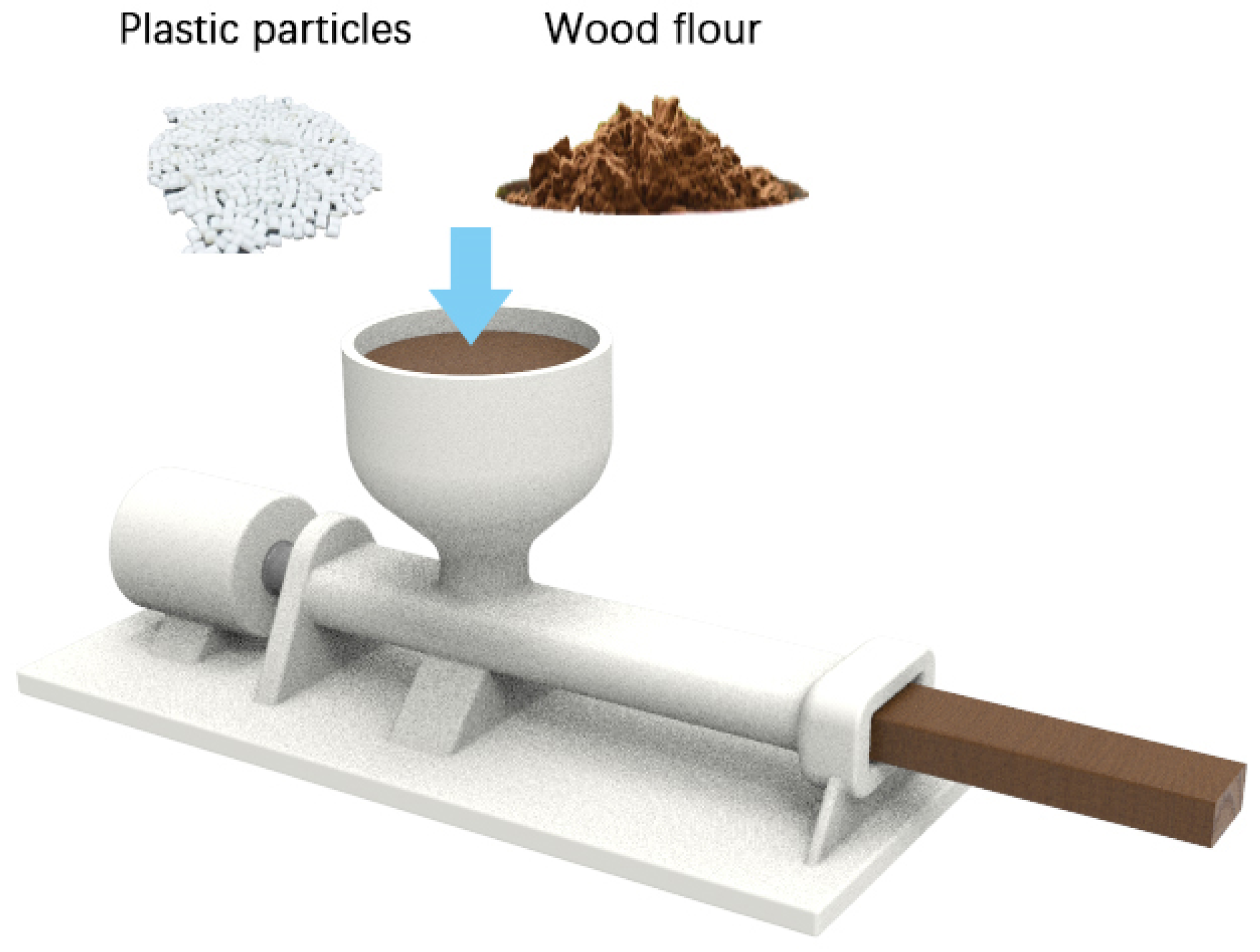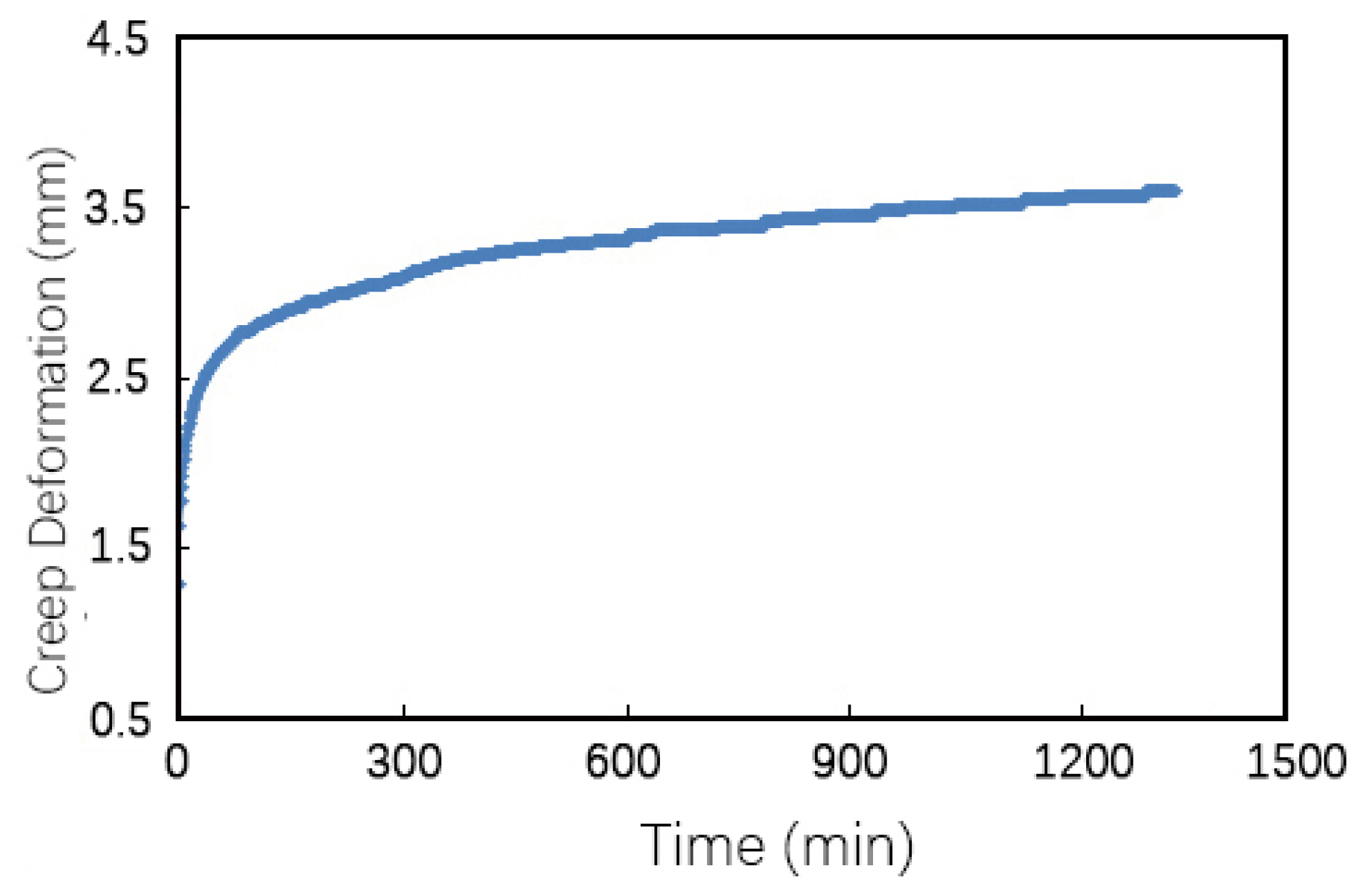Analysis of Factors Affecting Creep of Wood–Plastic Composites
Abstract
:1. Introduction
2. Material Preparation Test
3. Creep Test
4. Results and Discussion
4.1. Creep Test Analysis
4.2. Analysis of Influencing Factors of Creep Performance
4.2.1. Effect of Temperature on Creep Strain
4.2.2. Effect of Load on Creep Strain
4.2.3. Effect of Humidity on Creep Strain
5. Conclusions
Author Contributions
Funding
Acknowledgments
Conflicts of Interest
References
- Fini, S.H.; Erchiqui, F.; Farzaneh, M. Investigating the elastic deformation of wood–plastic composites at cold temperature using the bubble inflation technique. J. Thermoplast. Compos. Mater. 2013, 28, 431–441. [Google Scholar] [CrossRef]
- Xu, Y.; Wu, Q.; Lei, Y. Creep behavior of bagasse fiber reinforced polymer composites. Bioresour. Technol. 2010, 101, 3280–3286. [Google Scholar] [CrossRef]
- Park, B.D.; Balatinecz, J.J. Short term flexural creep behavior of wood-fiber/polypropylene composites. Polym. Compos. 2010, 19, 377–382. [Google Scholar] [CrossRef]
- Sain, M.M.; Balatinecz, J.; Law, S. Creep fatigue in engineered wood fiber and plastic compositions. J. Appl. Polym. Sci. 2015, 77, 260–268. [Google Scholar] [CrossRef]
- Tamrakar, S.; Lopez-Anido, R.A.; Kiziltas, A.; Gardner, D.J. Time and temperature dependent response of a wood–polypropylene composite. Compos. Part A 2011, 42, 834–842. [Google Scholar] [CrossRef]
- Pulngern, T.; Chitsamran, T.; Chucheepsakul, S.; Rosarpitak, V.; Patcharaphun, S.; Sombatsompop, N. Effect of temperature on mechanical properties and creep responses for wood/pvc composites. Constr. Build. Mater. 2016, 111, 191–198. [Google Scholar] [CrossRef]
- Chang, F.C.; Lam, F.; Kadla, J.F. Using master curves based on time-temperature superposition principle to predict creep strains of wood-plastic composites. Wood Sci. Technol. 2013, 47, 571–584. [Google Scholar] [CrossRef]
- Oever MV, D.; Molenveld, K. Creep deflection of wood polymer composite profiles at demanding conditions. Case Stud. Constr. Mater. 2019, 10, e224. [Google Scholar]
- Zhou, D.; Lin, Q.; Chen, L. Effect of natural climate aging on creep properties of wood plastic composites. J. Fuzhou Univ. Nat. Sci. Ed. 2011, 39, 96–100. [Google Scholar]
- Lin, W.S.; Pramanick, A.K.; Sain, M. Determination of material constants for nonlinear viscoelastic predictive model. J. Compos. Mater. 2016, 38, 19–29. [Google Scholar] [CrossRef]
- Leea, S.; Yanga, H.; Kim, H. Creep behavior and manufacturing parameters of wood flour filled polypropylene composites. Compos. Struct. 2004, 65, 459–469. [Google Scholar] [CrossRef]
- Andrzej, K.; Bledzki, O.F. Creep and impact properties of wood fibre–polypropylene composites: Influence of temperature and moisture content. Compos. Sci. Technol. 2004, 64, 693–700. [Google Scholar]
- Lu, X.; Fang, Q.; Lu, Q.; Cheng, F.; Sun, X. Creep behavior of PP/wood flour composites. Plastics 2009, 38, 81–84. [Google Scholar]
- Xue, J.; Xue, P. Study on creep resistance of HDPE/wood flour composites. Appl. Eng. Plast. 2010, 38, 9–13. [Google Scholar]
- Yang, T.C.; Wu, T.L.; Hung, K.C.; Chen, Y.L.; Wu, J.H. Mechanical properties and extended creep behavior of bamboo fiber reinforced recycled poly(lactic acid) composites using the time–temperature superposition principle. Constr. Build. Mater. 2015, 93, 558–563. [Google Scholar] [CrossRef]
- Hung, K.C.; Wu, T.L.; Chen, Y. Assessing the effect of wood acetylation on mechanical properties and extended creep behavior of wood/recycled-polypropylene composites. Constr. Build. Mater. 2016, 108, 139–145. [Google Scholar] [CrossRef]
- Pulngern, T.; Chucheepsakul, S.; Padyenchean, C.; Rosarpitak, V.; Prapruit, W.; Chaochanchaikul, K.; Sombatsompop, N. Effects of cross-section design and loading direction on the creep and fatigue properties of wood/PVC composite beams. J. Vinyl Addit. Technol. 2010, 16, 42–49. [Google Scholar] [CrossRef]
- Xu, H.; Cao, Y.; Wang, W.; Wang, Q.; Wang, H. Effect of poplar fiber size on mechanical and creep properties of hot pressed poplar fiber/HDPE composites. J. Compos. Mater. 2016, 33, 1168–1173. [Google Scholar] [CrossRef]
- Homkhiew, C.; Ratanawilai, T.; Thongruang, W. Time–temperature and stress dependent behaviors of composites made from recycled polypropylene and rubberwood flour. Constr. Build. Mater. 2014, 66, 98–104. [Google Scholar] [CrossRef]
- Jiang, Y.; Li, D.; Wu, Z.; Ding, J. Study on creep properties of rice husk/HDPE wood plastic composites. Packag. Eng. 2008, 8, 4–6. [Google Scholar]
- Dong, Z. Simulation and prediction of creep behavior of polypropylene wood plastic composite. Polym. Mater. Sci. Eng. 2010, 26, 89–92. [Google Scholar]
- Tian, X.; Li, K.; Jiang, Y.; He, Q. Study of Creep behavior of wood plastic composites by different loading modes. Plast. Ind. 2008, 43–46. [Google Scholar] [CrossRef]
- ASTMD790. Standard Test Methods for Flexural Properties of Unreinforced and Reinforced Plastics and Electrical Insulating Materials; American Society for Testing and Materials: West Conshohocken, PA, USA, 2010. [Google Scholar]
- Li, F.; Zhao, C.; Deng, Z. A Creep Testing Device for Wood Plastic Composites. China ZL201720824845.1, 5 January 2018. [Google Scholar]
- ASTMD7031. Standard Guide for Evaluating Mechanical and Physical Properties of Wood-Plastic Composite Products; American Society for Testing and Materials: West Conshohocken, PA, USA, 2004. [Google Scholar]
- Jiang, Y.; Li, D.; Wu, Z. Effect of temperature on bending creep properties of rice husk/HDPE composites. J. Build. Mater. 2008, 11, 695–698. [Google Scholar]
- Xu, H.; Cao, Y.; Li, L.; Shan, W.; Hao, J.; Yang, X. Creep properties of Masson Pine and Chinese fir reinforced polymer composites. J. Fujian For. Univ. 2019, 39, 654–659. [Google Scholar] [CrossRef]
- Ou, R.; Yao, K.; Sun, L.; Liu, T.; Hao, X.; Liu, Z.; Zhou, H.; Wang, Q. Research progress on creep characteristics and prediction methods of wood plastic composites. J. Compos. 2021, 38, 1734–1753. [Google Scholar] [CrossRef]







| Test No | Molding Temp (°C) | Screw Speed (r·min−1) | Wood–Plastic Ratio | Coupling Agent | Granulation Temp (°C) | Bending Strength (MPa) |
|---|---|---|---|---|---|---|
| A1 | 1(150) | 1(30) | 1(55:45) | 1(2%) | 1(150) | 55.19 |
| A2 | 1(150) | 2(50) | 2(60:40) | 2(3%) | 2(160) | 58.25 |
| A3 | 1(150) | 3(70) | 3(65:35) | 3(4%) | 3(170) | 58.95 |
| A4 | 1(150) | 4(90) | 4(70:30) | 4(5%) | 4(180) | 66.71 |
| B1 | 2(160) | 1(30) | 2(60:40) | 3(4%) | 4(180) | 58.05 |
| B2 | 2(160) | 2(50) | 1(55:45) | 4(5%) | 3(170) | 58.45 |
| B3 | 2(160) | 3(70) | 4(70:30) | 1(2%) | 2(160) | 59.55 |
| B4 | 2(160) | 4(90) | 3(65:35) | 2(3%) | 1(150) | 62.06 |
| C1 | 3(170) | 1(30) | 3(65:35) | 4(5%) | 2(160) | 63.97 |
| C2 | 3(170) | 2(50) | 4(70:30) | 3(4%) | 1(150) | 62.45 |
| C3 | 3(170) | 3(70) | 1(55:45) | 2(3%) | 4(180) | 58.43 |
| C4 | 3(170) | 4(90) | 2(60:40) | 1(2%) | 3(170) | 53.47 |
| D1 | 4(180) | 1(30) | 4(70:30) | 2(3%) | 3(170) | 51.35 |
| D2 | 4(180) | 2(50) | 3(65:35) | 1(2%) | 4(180) | 60.14 |
| D3 | 4(180) | 3(70) | 2(60:40) | 4(5%) | 1(150) | 60.16 |
| D4 | 4(180) | 4(90) | 1(55:45) | 3(4%) | 2(160) | 57.33 |
| Test No. | Load (MPa) | Temperature (°C) | Humidity (%) | Strain (%) |
|---|---|---|---|---|
| 1 | 1(50% of stress) | 1(30) | 1(45) | 1.76 |
| 2 | 1(50% of stress) | 2(35) | 2(55) | 1.94 |
| 3 | 1(50% of stress) | 3(40) | 3(65) | 2.45 |
| 4 | 2(40% of stress) | 1(30) | 3(65) | 1.02 |
| 5 | 2(40% of stress) | 2(35) | 1(45) | 1.28 |
| 6 | 2(40% of stress) | 3(40) | 2(55) | 1.67 |
| 7 | 3(60% of stress) | 1(30) | 2(55) | 2.21 |
| 8 | 3(60% of stress) | 2(35) | 3(65) | 2.44 |
| 9 | 3(60% of stress) | 3(40) | 1(45) | 3.28 |
| Load (MPa) | Temperature (°C) | Humidity (%) | |
|---|---|---|---|
| Q1 | 6.15 | 4.99 | 6.32 |
| Q2 | 3.97 | 5.66 | 5.82 |
| Q3 | 7.83 | 7.4 | 5.91 |
| q1 | 2.05 | 1.66 | 2.11 |
| q2 | 1.32 | 1.89 | 1.94 |
| q3 | 2.64 | 2.47 | 1.97 |
| r | 1.32 | 0.81 | 0.17 |
| Type III Sum of Squares | df (Freedom) | Mean Square | F | Sig. (Significance Level) | |
|---|---|---|---|---|---|
| Calibration Model | 3.701 a | 6 | 0.617 | 47.905 | 0.021 |
| Intercept | 36.200 | 1 | 36.200 | 2811.066 | 0.000 |
| Load | 2.622 | 2 | 1.311 | 101.822 | 0.010 |
| Temperature | 1.032 | 2 | 0.516 | 40.054 | 0.024 |
| Humidity | 0.047 | 2 | 0.024 | 1.839 | 0.352 |
| Deviation | 0.026 | 2 | 0.013 | ||
| Total | 39.927 | 9 | |||
| Corrected Total | 3.727 | 8 |
| Load | N | Subset | Temperature | N | Subset | Humidity | N | Subset | |||
|---|---|---|---|---|---|---|---|---|---|---|---|
| 1 | 2 | 3 | 1 | 2 | 1 | ||||||
| 40% | 3 | 1.323 | 30 °C | 3 | 1.663 | 55% | 3 | 1.94 | |||
| 50% | 3 | 2.05 | 35 °C | 3 | 1.887 | 65% | 3 | 1.97 | |||
| 60% | 3 | 2.643 | 40 °C | 3 | 2.467 | 45% | 3 | 2.107 | |||
| Sig. | 1 | 1 | 1 | Sig. | 0.137 | 1 | Sig. | 360 | |||
Publisher’s Note: MDPI stays neutral with regard to jurisdictional claims in published maps and institutional affiliations. |
© 2021 by the authors. Licensee MDPI, Basel, Switzerland. This article is an open access article distributed under the terms and conditions of the Creative Commons Attribution (CC BY) license (https://creativecommons.org/licenses/by/4.0/).
Share and Cite
Feng, L.; Xie, W. Analysis of Factors Affecting Creep of Wood–Plastic Composites. Forests 2021, 12, 1146. https://doi.org/10.3390/f12091146
Feng L, Xie W. Analysis of Factors Affecting Creep of Wood–Plastic Composites. Forests. 2021; 12(9):1146. https://doi.org/10.3390/f12091146
Chicago/Turabian StyleFeng, Li, and Weiren Xie. 2021. "Analysis of Factors Affecting Creep of Wood–Plastic Composites" Forests 12, no. 9: 1146. https://doi.org/10.3390/f12091146
APA StyleFeng, L., & Xie, W. (2021). Analysis of Factors Affecting Creep of Wood–Plastic Composites. Forests, 12(9), 1146. https://doi.org/10.3390/f12091146





